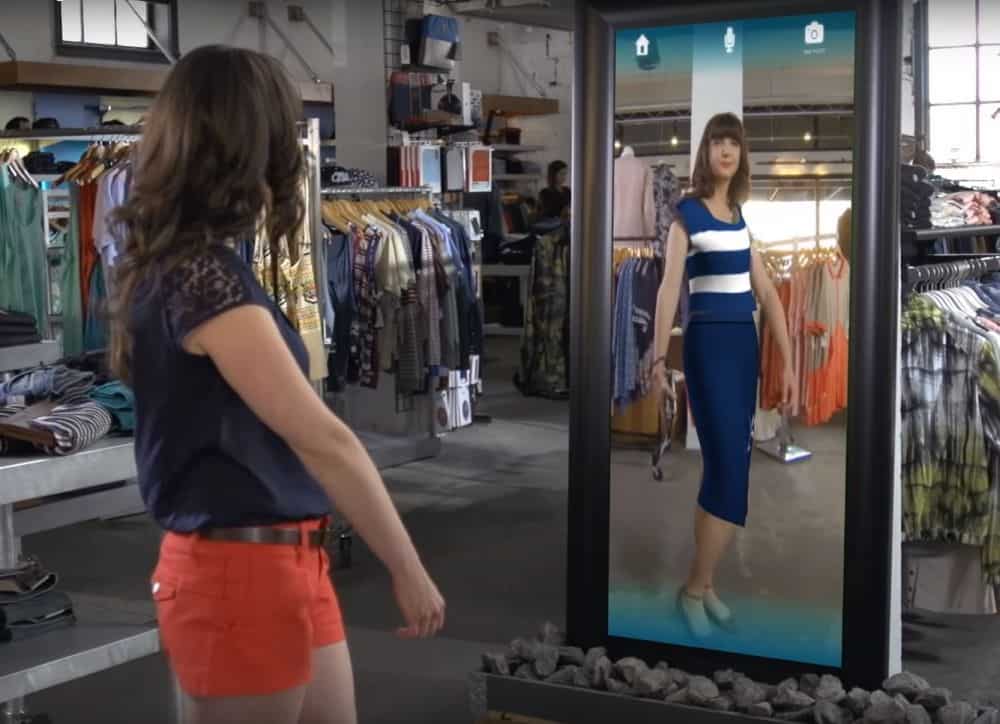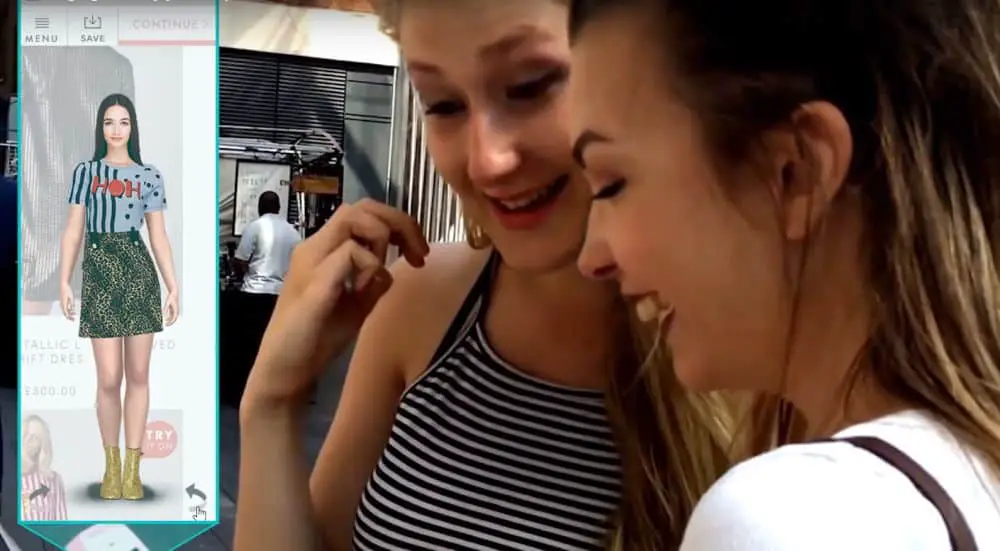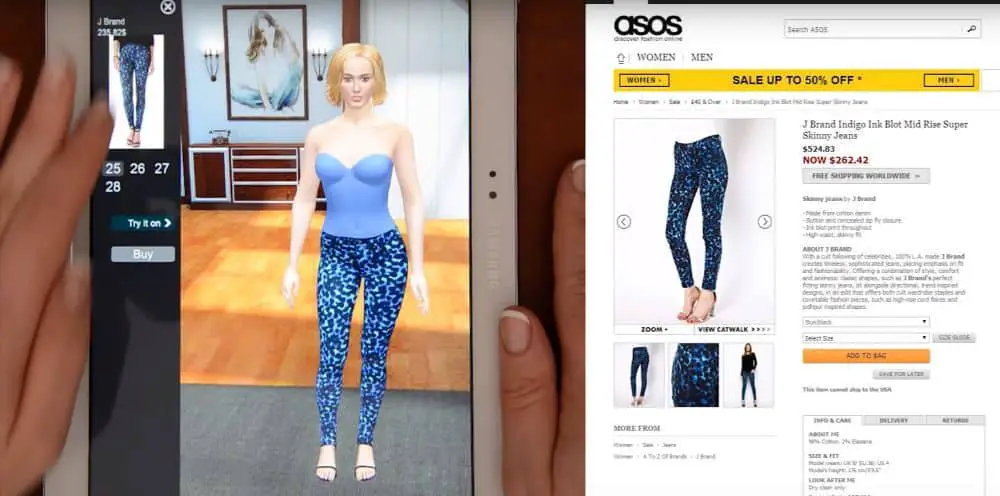Shopping is something that some people enjoy immensely, others less so. But whether or not you enjoy spending hours wandering around stores, chances are, every once in a while you just have to buy new clothes.

As we are living in the 21st century, we have the blessing of online shopping. Its big downside, though, is the fact you can’t try the items on – in many cases meaning the item won’t end up fitting properly and you have to return it. However, technology might be able to solve this issue, as augmented reality offers great options for help with clothes fitting.
There are different ways in which AR can help make clothes fitting easier and more comfortable – most importantly, virtual fitting rooms and augmented reality mirrors. I’ll be giving an overview of these and telling you more about how they work.
Virtual fitting rooms help you envision the garment on you
First we have virtual fitting rooms, which are perhaps the most commonly known out of these. Virtual fitting rooms help you envision what the particular item of clothing would look like on you, or a body type very close to yours.
An example of this type of fitting room comes from the app Pictofit. To use Pictofit, you insert a full-body photo of yourself and then pick items you would like to buy. The app then “puts” those clothes on you, so you’re able to get an idea of what the clothes would look like on you.
However, the shortfall of Pictofit is that it’s rendering a flat image of you in the clothes, rather than 3D. Since everything is flat, it means you’re probably not getting the exact representation of what the clothing would actually look like you, as the fabric wouldn’t fall realistically on a 2D model.
Next to Pictofit, there are countless alternatives, which offer very similar solutions. For example, we have Metail. Metail is quite similar to Pictofit, as it helps you imagine clothing items from various retailers on a model of your measurements.
You insert your measurements and body size, choose a model (one of whom is Meghan Markle, for some reason?!), choose the clothing item, and the app does the rest of the magic for you. Although, one downfall of Metail is that it does not have options for trying clothes on men.
So if you are wanting a 100% accurate representation of what the item would look like on you, these apps might not be for you. But you’ve got to hand it to them, they are quite useful for planning outfits and seeing what items could possibly be paired with each other.

They can give you a general sense of how different coloured garments could look against your skin tone. For example – you, female reader, can find out whether or not you could rock that brightly coloured top you’ve had your eye on for a while now.
They seem to work in favour of retailers too, as we can see from the statistics on the Metail website. They claim that with the use of their app, the sales per visitor go up by up to 22% and returns can be reduced by 5%.
In addition to these, they claim that the use of Metail has helped customers stay on the site for up to 3.5 times longer and has increased engagement and adoption rates up to 76%. So these types of fitting rooms definitely have benefits for both customers and retailers alike.
3D body models providing incredibly accurate representation of garments
Next, let’s take a look at a different type of virtual fitting rooms, which could possibly help with the struggle of flat visuals. Instead of creating a 2D visual, they render a 3D image of the model wearing the items.
An example of this is Avametric, who created the Gap virtual dressing room, appropriately called DressingRoom. The DressingRoom caused a lot of buzz when it was first released because of how innovative it was.
The idea of the app was that the customer is able to pick a body avatar similar to theirs in size and then try on different GAP clothing items, getting an idea of what the clothes would look like in 3D.
However, the idea of the GAP DressingRoom might have been abandoned – when I tried finding more recent information on it, I couldn’t come up with anything. Regardless, Avametric, who created the app, have kept themselves busy creating several similar apps.
They seem to specialize in this field – according to their website they “enable brands to deliver accurate 3D renderings of apparel and accessories on customizable digital body models for web, mobile and AR”. In addition to having worked with GAP, they have also partnered with retailers such as Ann Taylor and Alternative Apparel, as well as having their own iOS app called Fitting Room.
If you’re looking for a solution that would enable you to get as close an idea as possible of what a particular item of clothing would look on your body type from the comfort of your own home, then this type of a 3D virtual dressing room might be the best option for you.

It’s great because when rendering garments and body models, the thickness, weight and texture of the fabrics are taken into account, as well as individual body types.
However, separately creating 3D renderings of each garment would be quite time-consuming and costly, especially considering the fact retailers tend to add and remove items from their stock fairly often. This might be why not too many retailers are currently using these 3D types of virtual dressing rooms.
One can only hope, though, that in the future, retailers will realize the benefits of these and start incorporating them in their businesses. I imagine it would be of great help in reducing the number of returns.
High-tech augmented reality mirrors
Now, let’s move on to the next solution in which AR can be used in virtual clothes fitting. That is – augmented reality mirrors. Yes, you heard me right. These are in-store mirrors, which, applying AR technology, help the customer see what the items off the rack would look like on them.
The mirrors work based on Microsoft Kinect technology and enable you to see yourself with the 3D copy of the clothing item.
Similar AR mirrors are being employed by big-shot names such as Topshop, Timberland, Amazon (a patent has been issued), as well as make-up retailers, such as Charlotte Tilbury, Mac and Sephora.
One could beg the question of why this type of invention is even needed, as the client has already made their trip down to the store and could just as easily go to the physical dressing room – which I can understand, yes, it is a fair point.
But I mean, think about it. Given the choice of either spending 15 minutes trying to get on one item of clothing, fussing about with the endless amounts of zippers and buttons, OR seeing a visualization of you wearing the garment within seconds? Yeah, I personally would most likely opt for the second one.
Again, these AR mirrors aren’t too common as of now, but as time goes on, we might just start seeing more of them popping up in stores. In fact, according to statistics, 61% of shoppers prefer shopping at stores, which offer augmented reality solutions over stores that don’t. 40% would be willing to pay more for items if they could experience it through augmented reality.
Conclusion
It is clearly visible how augmented reality is already starting to influence the shopping experience, both in virtual fitting room context, as well as using AR mirrors in actual brick and mortar stores.
Though the idea of this sort of technology might seem foreign at first, hopefully more people will see the practicality of such apps. One can only assume that this impact of AR in clothes fitting will only grow over time and hopefully, eventually lead to less returns in online shopping.

